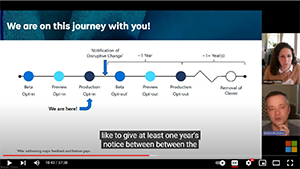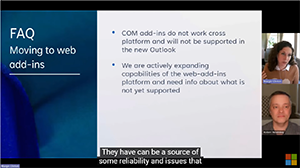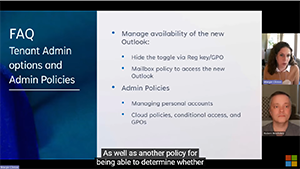News
New Outlook for Windows To Arrive in 2 Years
- By Kurt Mackie
- September 13, 2023
Microsoft is redoing its 25-year-old Outlook for Windows product, with plans to replace the current product in about two years.
Those plans were outlined by Microsoft luminaries Margie Clinton, group product manager on the Outlook team, and Robert Novitskey, partner engineering manager for Outlook for Windows, in an online presentation published last week. It's accessible via in this Sept. 12 Microsoft announcement.
The new Outlook for Windows is getting lots of feature improvements, but much of this talk focused on timing issues, as well as IT department concerns about the transition away from the current Outlook for Windows product.
Clinton said that Microsoft had no strict timeline for the end of life of the "classic" Outlook for Windows product. Microsoft's timing is "going to be determined on overall readiness, based on us delivering the core capabilities to the point where we believe that we're ready for opt out." However, she added that the end of the classic product is coming, and it would occur maybe "in a little bit more than two years."
Novitskey said that the coming new Outlook for Windows client app can be a big change for large organizations with lots of users. He suggested that Microsoft's "support can work with you to kind of develop a personalized timeline, and they can secure kind of whatever extensions you may need for your tenant."
The online presentation offered the following slide, showing the expected phases for rolling out the new Outlook for Windows client app:
 [Click on image for larger view.]
Figure 1. Microsoft's rollout plan for the new Outlook for Window client app (source: Microsoft online presentation, published Sept. 5, 2023).
[Click on image for larger view.]
Figure 1. Microsoft's rollout plan for the new Outlook for Window client app (source: Microsoft online presentation, published Sept. 5, 2023).
Novitskey noted that Microsoft tries to give a one-year advance notice of disruptive changes for its commercial software. IT pros will get such a notice via the Message Center. Microsoft eventually will switch the apps, though, which Novitskey called a "cutover":
But at some point, we will decide that we think that the new outlook is good enough for all users and we will interface, called "cutover." And this is where classic Outlook or universal mail and calendar are no longer supported. And so, users will have to move to the new Outlook.
Some things won't work in the new Outlook for Windows, namely COM add-ins. Instead, the new Outlook for Windows will use Web add-ins. The following slide made those declarations:
 [Click on image for larger view.]
Figure 2. The new Outlook for Windows will use Web add-ins, and will drop support for COM add-ins (source: Microsoft online presentation).
[Click on image for larger view.]
Figure 2. The new Outlook for Windows will use Web add-ins, and will drop support for COM add-ins (source: Microsoft online presentation).
Microsoft initially plans to roll out the new Outlook for Windows app as an option for users, with a toggle switch to try it located at the top right corner of the legacy client. The toggle switch, currently in the "Off" position by default, now appears for organizations that are using the monthly enterprise channel releases of Microsoft 365, Novitskey said.
IT pros initially will get Registry and Group Policy Object controls over whether end users can see this toggle switch, before total replacement with the new app. The IT controls were briefly outlined in the following slide:
 [Click on image for larger view.]
Figure 3. Administrator controls for the coming new Outlook for Windows app (source: Microsoft online presentation).
[Click on image for larger view.]
Figure 3. Administrator controls for the coming new Outlook for Windows app (source: Microsoft online presentation).
The new Outlook for Windows has a more simplified user interface, which looks somewhat like its Outlook on the Web predecessor. However, Microsoft is really making the switch to the new app because its current Outlook for Windows app is available in more than three offerings that all work differently, Clinton explained. Instead, with the new product, Microsoft wants to "apply all of our engineering energy on Windows into delivering and then maintaining a single, fast and agile codebase," she added. This change will allow Microsoft to address customer issues in hours and days, rather than weeks and months.
The new Outlook for Windows client will be customizable for various users. It also will get Microsoft's artificial intelligence enhancements, which Microsoft believes will deliver a "10x productivity" improvement, Clinton said.
Microsoft really wants to earn "Outlook love" with the new client, and so is actively seeking early feedback from organizations, Clinton indicated.
About the Author
Kurt Mackie is senior news producer for 1105 Media's Converge360 group.